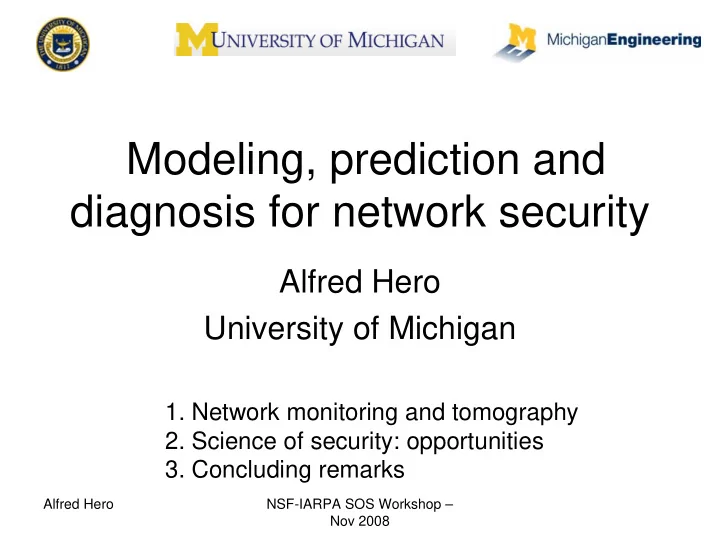

Modeling, prediction and diagnosis for network security Alfred Hero University of Michigan 1. Network monitoring and tomography 2. Science of security: opportunities 3. Concluding remarks Alfred Hero NSF-IARPA SOS Workshop – Nov 2008
1. Network monitoring and tomography • Internally sensed network tomography (Treichler05, Rabbat06) C A ? D B E • End-point prediction and tracking(Justice06) ? ? ? ? ? ? Alfred Hero NSF-IARPA SOS Workshop – Nov 2008
2. Science of security: opportunities • Science of Security • Scientific method – Sparse, incomplete? – Observation – Model selection? – Hypothesis – Baseline drift? – Prediction – Observer effect? – Experiment – Benchmarks? – Evaluation Alfred Hero NSF-IARPA SOS Workshop – Nov 2008
Observation • Challenge: Critical security breaches are covert, rare, and non-repeatable – Any set of observations will necessarily be sparse and incomplete – Persistent and pervasive multimodal monitoring impractical Alfred Hero NSF-IARPA SOS Workshop – Nov 2008
Cross-fertilizations • Information-driven sensor management – Plan-ahead learning with POMDP (Carin:06, Blatt06) – Q-learning for reactive targets (Kreucher:06) – Performance prediction (H07, Castanon08) • ISNT applications (Rabbat08,Justice06), but more research needed – Necessary and sufficient sampling rate? – Distributed processing and inference? – Scalable algorithms and approximations? Alfred Hero NSF-IARPA SOS Workshop – Nov 2008
Hypothesis • Challenge: infer stable models of attack and ambient behaviors that can be reliably tested – Central question: how to discover hidden latent structure of partially observed variables? Alfred Hero NSF-IARPA SOS Workshop – Nov 2008
Cross-fertilizations • Statistical model selection: how many attack patterns are there and how to identify them? • Unsupervised hypothesis generation – Bayesian factor analysis (West05) – Information driven PCA (FINE, IPCA) (Carter08_b) – Complexity filtering (Carter08_a) – Social networks of behavoir (Xu09) • How to make these approaches scalable to whole network security applications? Alfred Hero NSF-IARPA SOS Workshop – Nov 2008
Complexity filtering (Carter:08_a) Intrinsic dimension estimator Abilene Netflow data (Total number packets) Alfred Hero NSF-IARPA SOS Workshop – Nov 2008
SocNet of SPAM harvestors (Xu:09) Alfred Hero NSF-IARPA SOS Workshop – Nov 2008
SocNet of SPAM harvestors (Xu:09) Alfred Hero NSF-IARPA SOS Workshop – Nov 2008
Prediction • Challenge: learn truly predictive and generalizable models that – Track dynamic shifts over time or space – Extract information from high dimension – Integrate uncalibrated diverse data types Alfred Hero NSF-IARPA SOS Workshop – Nov 2008
Cross-fertilizations • Predictive anomaly detection –Transductive learning (Scott08) – Geometric entropy minimization (H06) • Flexible graphical/topological models • How to make these methods scalable? –decomposable version of Lakhina04's PCA for whole-network diagnosis Alfred Hero NSF-IARPA SOS Workshop – Nov 2008
Dynamic dwMDS for Abilene (Patwari:05) Alfred Hero NSF-IARPA SOS Workshop – Nov 2008
Experiment • Challenge: simulation relies on stale or speculative models while real-world data collection is difficult due to – Disruption of infrastructure – Unreliable ground truth – Significant “observer effects” Alfred Hero NSF-IARPA SOS Workshop – Nov 2008
Cross-fertilizations • Adversarial experiment design approaches – Dynamic generalizations of adversarial classification (ACRE, Lowd&Meek06, Dalvi04 ) and greedy minimax (Kraus07) – RL w observer effect (Kreucher06, Murphy06) • Design of experiments for medical clinical trials have similar constraints Alfred Hero NSF-IARPA SOS Workshop – Nov 2008
Evaluation • Challenge: establish reliable methods of on- line and offline performance prediction – Incomplete label information/ground truth – Curse of dimensionality • require order 1/ e p samples to determine the values of p experimental variables within error e Alfred Hero NSF-IARPA SOS Workshop – Nov 2008
Cross-fertilizations • Bayesian meta-analysis: what is posterior uncertainty of predicted estimation error? • DOE benchmarking: what is theoretically attainable algorithm performance? – Coding and information theory • Error exponents, Fano, Rate-Distortion bounds • Tradeoffs between security and usability (H03) – Minimax, maximax and minimin performance prediction: function estimation and imaging (BickelRitov:90,KostolevTsybakov:93) Alfred Hero NSF-IARPA SOS Workshop – Nov 2008
3. Final remarks • Developing a Science of Security is challenging. • Leverage from other disciplines with high throughput data – Image reconstruction and tomography – Social networks and economic behavior models – Genetics, immunology, and epidemioogy • Main open problems – Adversarial learning environment – Rapidly changing baseline – Data impoverishement – Scalable plan ahead sampling Alfred Hero NSF-IARPA SOS Workshop – Nov 2008
Recommend
More recommend